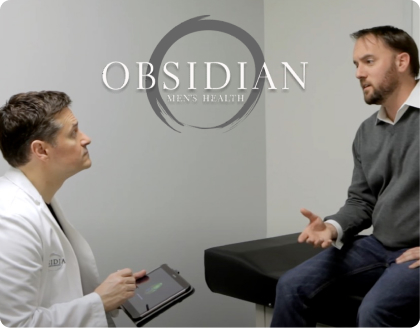Erectile dysfunction (ED) can feel like a deeply personal struggle, but it’s far more common than most men realize. In fact, over 30 million men in the U.S. experience some form of ED. And yet, too many suffer in silence, believing their only options are pills that don’t always work or surgery they want to avoid.
At Obsidian Men’s Health, we want to change that narrative. There are highly effective, non-surgical treatments for erectile dysfunction that restore function, confidence, and intimacy. Whether you’re just starting to explore solutions or feel like you’ve tried everything, understanding your options can be a game changer.
What Is Erectile Dysfunction, Really?
Erectile dysfunction isn’t just about occasional performance issues; it’s the ongoing inability to achieve or maintain an adequate erection firm enough for intercourse. ED can happen for many reasons, and the cause isn’t always obvious. For some men, it’s physical. For others, it may be mentall. In most cases, it’s a mix of both.
Common causes of ED can include:
- Reduced arterial blood flow due to vascular disease.
- Leaky penile veins causing venous leak.
- Low testosterone or other hormone imbalances.
- Psychological factors like anxiety or depression.
- Nerve damage from diabetes, prior surgery or injury.
- Side effects from medications.
The good news? You don’t need surgery to treat most of these underlying issues.
Why Non-Surgical ED Treatments Matter
Surgery is rarely the first—or best—solution for erectile dysfunction. While penile implants or vascular procedures can help some men with severe or treatment-resistant ED, most men can see dramatic improvement with less invasive therapies.
Non-surgical treatments often:
- Target the root cause rather than just the symptoms.
- Offer quicker recovery and fewer risks.
- Allow for more natural, spontaneous sexual experiences.
- Preserve sensation and sensitivity.
Let’s walk through the most effective, non-surgical ED treatments available.
1. Oral Medications (PDE5 Inhibitors)
These are often the first-line treatment for ED, and for good reason. PDE5 inhibitors such as Viagra and Cialis work by increasing blood flow to the penis in response to arousal. They don’t cause automatic erections, but they make it easier to achieve and maintain one with stimulation.
Pros:
- Easy to use and fast-acting.
- Effective for many men, especially those with mild to moderate ED.
- Cialis offers long-lasting effects (up to 36 hours) and also has a daily dosing option.
Limitations:
- Not effective for men with severe ED.
- Can cause side effects like headache, flushing, or nasal congestion.
- Rare cases of visual and hearing loss have been reported.
- Not recommended if you take nitrates for heart disease.
- Other drug-drug interactions are possible.
These medications are a great place to start, but if they’re not enough, other options are available. Many online and brick & mortar “ED clinics” sell compounded versions of these PDE5 inhibitors. These should be avoided. They are not FDA approved so they have not been rigorously studied for safety and efficacy. These products often combine more than one PDE5 inhibitor at inappropriate doses along with other drugs that have little to no efficacy in treating ED.
2. Testosterone Replacement Therapy (TRT)
Low testosterone is a major, often overlooked cause of erectile dysfunction. If you have ED along with symptoms like low libido, fatigue, irritability or poor sleep, low T could be part of the picture. A comprehensive hormone panel can reveal whether TRT might help improve not just your erections, but your energy, mood and overall vitality.
Pros:
- Addresses the hormonal root cause of ED.
- Often improves libido, stamina, and sexual confidence.
- Personalized dosing options (injections, pellets, creams, etc.).
Limitations:
- Requires ongoing monitoring and blood work.
- Results take time, often several weeks or months.
- Not a direct fix for mechanical blood flow issues.
TRT is rarely a solo fix for ED, but when paired with other therapies, it can be a powerful part of the solution. For example, oral ED medications like Viagra simply do not work well in the face of low testosterone. Treating a patient’s low testosterone can make oral ED drugs more effective.
3. Shockwave Therapy (Low-Intensity Extracorporeal Shockwave Therapy)
Shockwave therapy uses targeted acoustic waves to stimulate the release of growth factors in the penis such as vascular endothelial growth factor (VEGF). VEGF promotes blood vessel growth (angiogenesis) to improve the vascular health of the penis. LISWT may also promote better endothelial function of existing blood vessels.
Pros:
- Non-invasive.
- Treats the underlying cause of ED (poor arterial circulation).
- Improves spontaneous erections over time.
- No downtime and minimal side effects.
Limitations:
- Requires multiple sessions (typically 8–12 over 4-5 weeks).
- It may not be effective for men with severe ED.
- Not yet covered by all insurance providers.
For men seeking a natural, regenerative solution, shockwave therapy is one of the most promising breakthroughs in ED treatment today.
4. Vacuum Erection Devices (VEDs)
A vacuum erection device uses a pump to draw blood into the penis, followed by a constriction ring to maintain the erection. While it’s a more mechanical solution, it’s entirely non-invasive and can be effective when medications fail.
Pros:
- No medication required.
- Safe for men with heart conditions who cannot use oral ED drugs.
- Can be used as needed without systemic side effects.
Limitations:
- Less spontaneous or natural-feeling.
- It can cause bruising or discomfort if misused.
- Requires coordination and prep.
Though not a permanent fix, VEDs can be a great option for men who want an on-demand, drug-free solution.
5. Injections and Urethral Suppositories (Second-Line Therapies)
Medications like alprostadil can be delivered via penile injection or urethral suppository. These methods deliver fast, direct blood flow stimulation to the erectile tissue.
Pros:
- Effective even when PDE5 inhibitors fail.
- Results within 5–15 minutes.
- Often used in men with diabetes, prostate surgery, or advanced ED.
Limitations:
- Injections require proper training and confidence.
- Risk of pain, scarring, or priapism (prolonged erection).
- Not ideal for long-term daily use.
While more invasive than pills or shockwave therapy, these options are still far less invasive than surgery, and often very effective.
Combining Treatments for Better Results
ED is rarely caused by a single issue, which is why a one-size-fits-all treatment often falls short. At Obsidian, we specialize in creating custom treatment plans based on your specific underlying medical issues, symptoms, and lifestyle.
When to Seek Help
If you’ve experienced consistent erectile issues for more than a few months, don’t wait for things to magically improve. ED can be an early warning sign of more serious conditions like heart disease, diabetes or hormone deficiency.
Ask yourself:
- Are my erections less frequent, firm or reliable than they used to be?
- Do I avoid sex or intimacy due to fear of performance issues?
- Have I lost confidence or felt disconnected from my partner?
If the answer is yes, it’s time for a real solution, one guided by expert urologists who specialize in men’s health.
Erectile dysfunction may feel isolating, but you’re far from alone—and you’re not out of options. Surgery is rarely necessary. With the right non-surgical treatment plan, you can restore sexual function, rekindle confidence, and reclaim a part of yourself you may have thought was gone.
At Obsidian Men’s Health, we dig deeper to understand your body, your hormones and your goals to help you get back to being you. Request a consultation with our men’s health specialists to take control of your sexual health.

